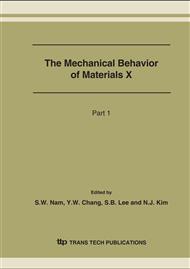[1]
B. Riccardi, L. Giancarli, A. Hasegawa, Y. Katoh, A. Kohyama, R.H. Joines and L.L. Snead: J. Nucl. Mater., Vol. 329-333 (2004), p.56.
Google Scholar
[2]
R. W. Messler, Jr.: Joining of Materials and Structures, (ElsevierButterworth-Heinemann, USA 2004).
Google Scholar
[3]
H. Serizawa, H. Murakawa and C.A. Lewinsohn: Ceram. Trans., Vol. 144 (2002), p.335.
Google Scholar
[4]
H. Serizawa, C. A. Lewinsohn, M. Singh and H. Murakawa: Mater. Sci. Forum, Vol. 502 (2004), p.69.
Google Scholar
[5]
M. Singh: Key Engineering Materials, Vol. 164-165 (1999), p.415.
Google Scholar
[6]
C. A. Lewinsohn, M. Singh, T. Shibayama, T. Hinoki, M. Ando, Y. Katoh and A. Kohyama: J. Nucl. Mater., Vol. 283-287 (2000), p.1258.
DOI: 10.1016/s0022-3115(00)00247-6
Google Scholar
[10]
[0] [10] [1] [10] [2] Scale Parameter r 0 (µ m).
Google Scholar
[10]
[1] [10] [2] [10] [3] [10] [4] [10] [5] Fracture Load (N) Without Inherent Strain With 5. 0 x 10 -4 Inherent Strain With 1. 0 x 10 -3 Inherent Strain Thickness of Joint = 1 µ m -1 Fig. 2 Effect of r0 and inherent strain on fracture load in lap joint (1 µm thickness).
DOI: 10.1080/09507116.2012.708501
Google Scholar
[10]
[0] [10] [1] [10] [2] Scale Parameter r 0 (µ m).
Google Scholar
[10]
[1] [10] [2] [10] [3] [10] [4] [10] [5] Fracture Load (N) Without Inherent Strain With 5. 0 x 10 -4 Inherent Strain With 1. 0 x 10 -3 Inherent Strain Thickness of Joint = 10 µ m -1 Fig. 3 Effect of r0 and inherent strain on fracture load in lap joint (10 µm thickness).
DOI: 10.1080/09507116.2012.708501
Google Scholar
[10]
[0] [10] [1] [10] [2] Scale Parameter r 0 (µ m).
Google Scholar
[10]
[1] [10] [2] [10] [3] [10] [4] [10] [5] Fracture Load (N) Without Inherent Strain With 5. 0 x 10 -4 Inherent Strain With 1. 0 x 10 -3 Inherent Strain Thickness of Joint = 100 µ m -1 Fig. 4 Effect of r0 and inherent strain on fracture load in lap joint (100 µm thickness).
DOI: 10.1080/09507116.2012.708501
Google Scholar
[10]
[0] [10] [1] [10] [2] [10] [3] Scale Parameter r 0 (µ m).
Google Scholar
[10]
[0] [10] [1] [10] [2] [10] [3] [10] [4] [10] [5] [10] [6] Fracture Load (N) Thickness of Joint = 50 µ m Thickness of Joint =100 µ m Thickness of Joint =200 µ m With 1. 0 x 10 -3 Inherent Strain -1 Fig. 5 Effect of r0 and joint thickness on fracture load in asymmetrical bending test.
DOI: 10.31390/gradschool_dissertations.2025
Google Scholar


